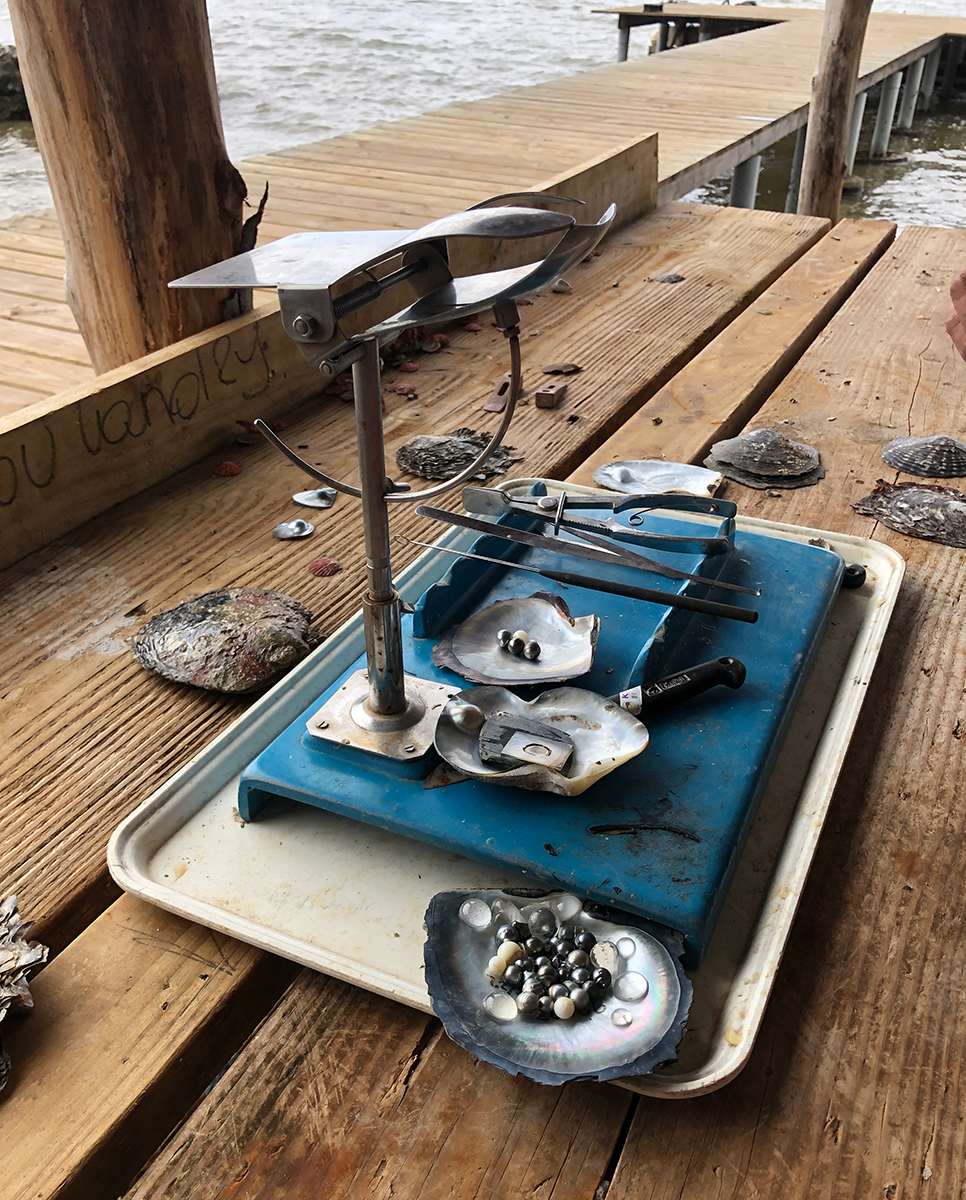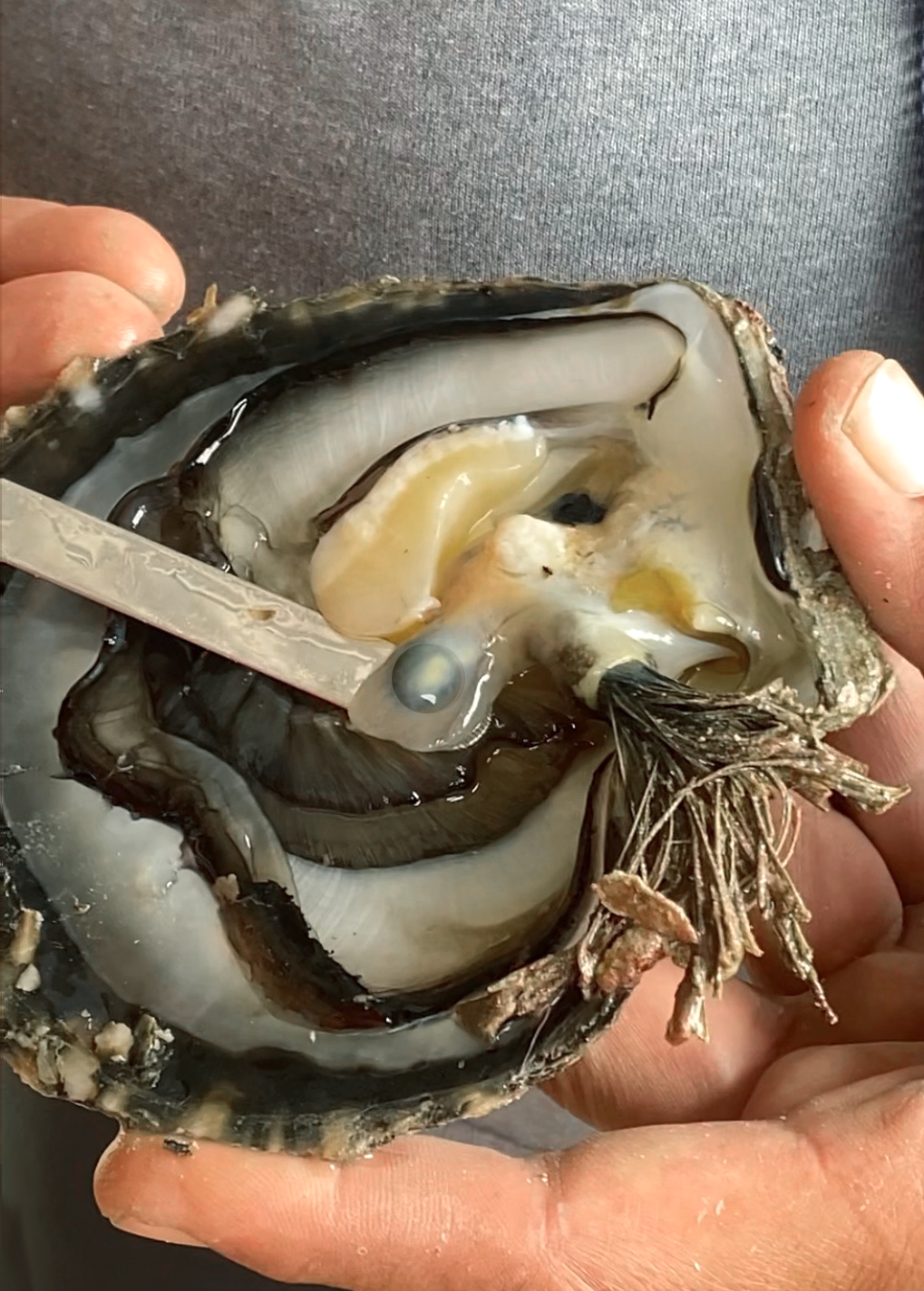Tahitian black oysters in baskets used for pearl cultivation.
In September 2023, April Higashi, owner and founder of Shibumi Gallery, traveled to Tahiti to visit some of its pearl farms to gain a BETTER understandING of the art of pearl cultivation, the sustainability practices surrounding the industry and meet the people and farmers who steward this unique industry.
The History of Tahitian Pearl Farming
Tahitian pearl farming, it turns out, is a fascinating story of environmental responsibility and human enterprise. The Pinctada margaritifera, the Polynesian black-lipped pearl oyster, is one of the largest pearl producing oysters in the world, measuring up to 12”. Its black, outer lip area is what gives the Tahitian pearls their unique, dark/black coloring. (Tahitian pearls are the only naturally ‘black’ pearls. Black pearls from other parts have the world are dyed to appear dark or black.)
Long before pearl farming began, the dark nacre (mother-of-pearl) from these oysters was highly sought after by Europeans for button making as well as in-lay for furniture. By the 1850s over-harvesting had led to a sharp decline in the oyster population. And 100 years later by the 1950s, the black-lipped oyster had nearly been harvested to extinction.
Realizing a big change was required to save their native oyster, in the 1960s locals began investing in pearl farming, which unlike harvesting for mother of pearl, does not kill the oyster.
Grafters from Japan were brought over to teach the art of grafting or seeding the oyster with a nucleus to entice the oyster to start making its ‘pearl-making process’. By the 1970s pearl farming had started to take off.
Today, not only is pearl farming Tahiti’s 2nd largest industry (tourism is first), the Pinctada margaritifera, is no longer endangered. A huge win for both the oysters and the Polynesian economy. And of course for those of us who enamored by these pearls with their unparalleled depth of colors.
Below are video vignettes from the adventure visiting the pearl farms made for April’s INSTAGRAM
or check out #tahitipearladventure🦪
La Orana!
Today, I am visiting a pearl farm on the island of Taha’a. This is one of the larger pearl farms in Tahiti. Once an oyster has been quickly opened and a nucleus implanted, the oyster gets put back in the sea for 18 to 24 months while the pearl forms. These oysters will be brought back up to the dock to be cleaned and checked for health every three-four months during this ‘gestation’ period. We watched as small boats with divers brought the ropes and baskets of oysters up for their cleaning and check-ups.
Here is a look into the art of pearl cultivation and basics of grafting.
Tahitian black pearls are produced by Polynesia’s native black-lipped oyster. The young oysters or ‘spats’ are only grown in one specific location in Tahiti. Once they are old enough (around 24-36 months) they can travel to the farms to be prepared for the grafting step of the pearl cultivation process. A nucleus (a small white bead) is carefully and meticulously implanted inside the oyster along with a 1-2mm piece of a donor mantle (a small bit of the outer edge of the muscle from another oyster).
It takes between 18 and 24 months for an oyster to form a pearl. (See the previous entry about caring for these oysters as the pearls are forming.) And of course, not all of the grafting will be successful. (Success rates vary but we were commonly told only 2-4 out of 10 grafted oysters will create a pearl of high enough quality to sell.)
After the 18-24 months, the oyster is quickly opened up to extract the pearl. If the pearl looks good, that oyster will have another nucleus embedded in its organ and the process will begin all over again. An oyster can be grafted up to three times in its lifetime.
In Tahiti, laborers are compensated with what can be termed as a living wage. Minimum wage in Tahiti starts at around $14 to $15 per hour for a 39 hour work week. For those possessing specialized skills, pay is considerably higher, possibly matching or even exceeding the wages in the United States. (Although, not quite reaching the levels of northern California.)
This glimpse into the cultivation process underscores the sheer dedication and years involved. Achieving a perfectly round, flawless pearls is indeed a rare feat. It takes approximately four years and 10,000 oysters to collect enough matched pearls to create a perfect strand of round pearl. I definitely gained a new appreciation for a beautiful round pearl. It’s a good thing I like the allure of the organic Baroque pearls and keshis!
I stumbled upon a remarkable pearl farm on the island of Ra’iatea.
In a tiny village surrounded by blue waters and lush, green mountains, we visited a small farm with a Japanese grafter. This shy, quiet man was not working that day, but returned to his workplace that morning wanting to greet the ‘Japanese artist’ who had come for a visit.
The farmers took us on their boat, out to a small house built on a reef where they work. The grafter’s workspace, a simple desk in the corner bathed in soft light, exuded serenity. The quality and colors of the pearls produced here were exceptional, and I sensed it was because of his artistry. This man truly understood that the process of grafting pearls is an art form.
We spent the morning here while static music played from a radio hanging from the rafters, creating an atmosphere that invited us to linger. As we dived off the pier, we saw the oysters swaying gently in their baskets. We savored a delicious lunch of fresh fish on the dock, while their showroom doubled as a changing station for swimsuits, while holding a treasure trove of these beautiful pearls.
While the grafter master behind the scenes was too shy to speak, his influence was undeniable. There are many steps and many hands needed to create a pearl. However, the grafter is the key to this magic. It was thanks to him that this small farm’s pearls possessed an array of colors unlike any we’d seen. This shy, unassuming man was more than just a grafter - he was also an artist.




